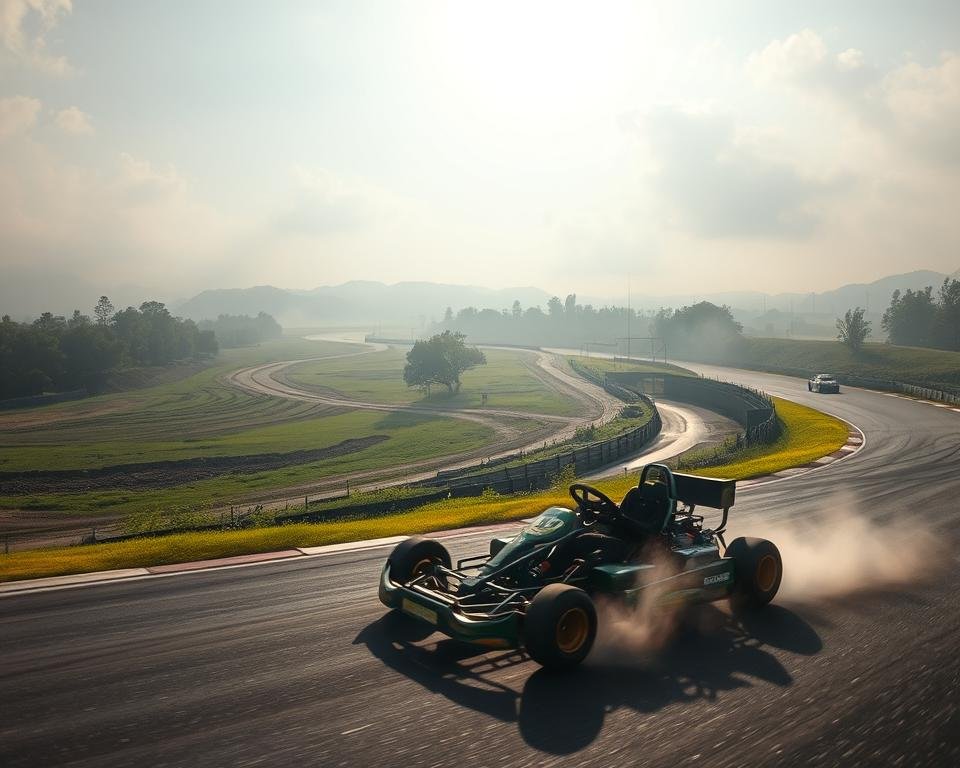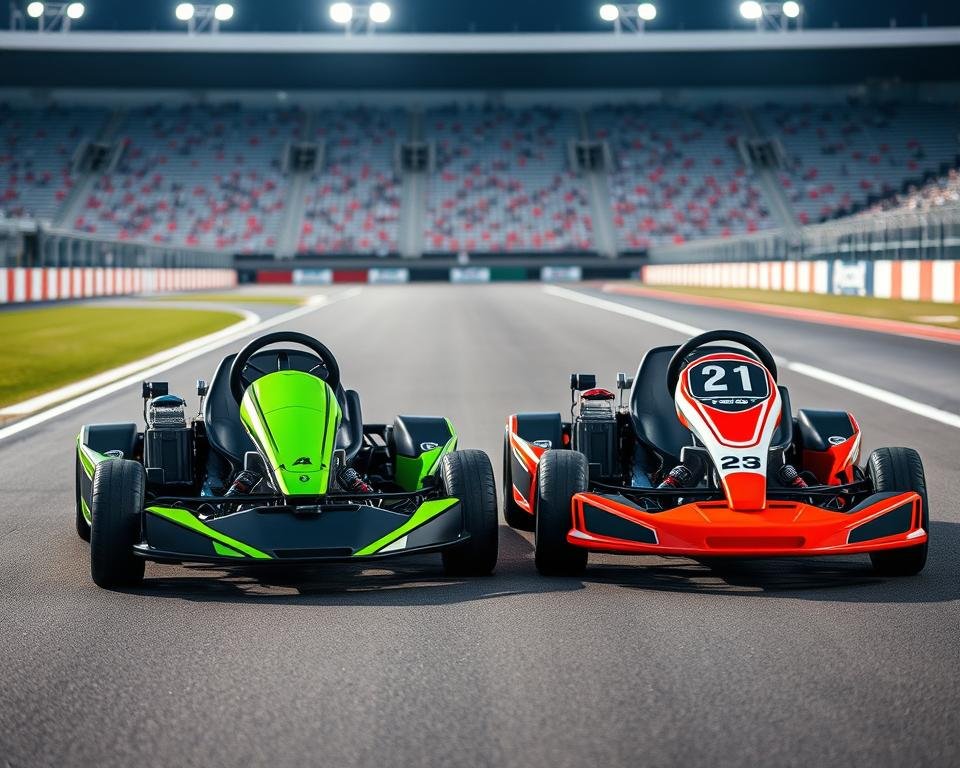Modern karting brings a critical decision: traditional combustion engines or cutting-edge electric motors. This choice shapes your track experience, costs, and environmental footprint. Whether you’re a weekend thrill-seeker or a competitive racer, understanding these options ensures you pick the right machine for your needs.
Combustion models have dominated tracks for decades, offering raw power and mechanical simplicity. Meanwhile, electric alternatives deliver instant torque and quieter operation. Your priorities—speed, sustainability, or budget—will steer this decision. Maintenance demands, energy efficiency, and safety features also play pivotal roles.
Karting isn’t just about adrenaline; it’s increasingly tied to environmental responsibility. Electric variants produce zero emissions during use, appealing to eco-conscious drivers. Gas-powered units, while louder and less green, often provide longer runtime between refuels. Balancing these factors requires careful thought.
This guide breaks down performance metrics, ownership costs, and technological innovations. You’ll learn how each option impacts your driving style and long-term satisfaction. From torque curves to charging logistics, we simplify the complexities so you can race with confidence.
Overview of Electric and Gas Go-Karts
Today’s karting innovations revolve around two distinct power systems. Battery-driven models use advanced energy storage paired with silent motors, eliminating exhaust fumes during operation. Combustion-powered units rely on refined petroleum engines that deliver classic mechanical feedback through sound and vibration.
Introduction to Go-Kart Technologies
Electric models draw energy from lithium-ion packs, sending instant power to their drivetrains. This setup provides consistent acceleration without gear shifts or engine warm-up periods. Combustion versions use precisely tuned carburetors and exhaust systems, creating the signature growl many drivers associate with racing.
Understanding the Comparison
Throttle response differs fundamentally between these systems. Battery-powered units push maximum torque immediately, while combustion engines need RPM buildup. Modern tracks see both types competing closely, thanks to improved battery cooling and lightweight engine designs.
Control interfaces showcase another contrast. Electric variants often feature adjustable power maps through digital dashboards. Traditional models maintain physical linkages between pedal movements and engine output, offering tactile feedback that purists enjoy. These technological paths create distinct driving experiences rather than outright superiority.
Electric vs. Gas Go-Karts: Which One Should You Choose?
Drivers face a pivotal choice when picking their kart’s power source. This decision shapes everything from track performance to long-term costs. Let’s examine critical distinctions and personal priorities that guide this selection.
Key Differences at a Glance
Instant acceleration defines battery-powered models, delivering maximum thrust from standstill. Combustion engines build speed gradually but achieve higher top velocities. Noise levels create another divide: silent electric motors suit indoor tracks, while roaring gas engines amplify outdoor racing thrills.
Environmental impact varies drastically. Electric versions leave no exhaust fumes during operation, aligning with green initiatives. Fuel-driven units require petroleum products but offer extended runtime per tank. Maintenance needs also differ – lithium-ion packs need charging expertise, while gas models demand oil changes and spark plug checks.
Factors Influencing the Decision
Your racing environment dictates practical constraints. Indoor facilities often restrict loud engines, making electric options preferable. Outdoor venues accommodate both types, though gas-powered performance shines on longer straights.
Budget considerations split between upfront costs and ongoing expenses. Battery systems cost more initially but save through lower energy bills. Combustion karts have affordable entry prices but recurring fuel costs. Session frequency matters too – quick battery swaps enable back-to-back electric races, while gas refills take moments but occur more often.
Lastly, assess your technical skills and environmental values. Managing charge cycles suits tech-savvy users, while engine tuning appeals to mechanical enthusiasts. Local emission rules and noise ordinances may simplify your choice based on regional regulations.
Environmental Impact and Noise Considerations
Racing enthusiasts now weigh ecological consequences alongside performance metrics. Air quality and sound management increasingly influence track operations and vehicle selection. Let’s explore how different propulsion systems affect surroundings and community relations.
Zero Emissions and Eco-Friendliness
Battery-powered models eliminate tailpipe exhaust completely during use. This makes them perfect for indoor facilities where ventilation challenges exist. Urban tracks near schools or hospitals also benefit from cleaner air.

Modern battery recycling programs extend these advantages beyond the track. Used power cells get repurposed for solar energy storage and industrial backup systems. This circular approach reduces waste while supporting renewable infrastructure.
Noise and Pollution Challenges
Combustion engines release carbon monoxide and unburned hydrocarbons during operation. Enclosed tracks can accumulate these emissions, requiring advanced filtration systems. Regular exposure risks differ significantly from open-air venues.
Decibel levels create another operational hurdle. While some drivers enjoy engine roars, communities often impose strict noise limits. Facilities near residential zones face curfews or permits restricting gas kart usage during evenings.
Fuel efficiency improvements help, but petroleum dependency remains an environmental concern. Electric alternatives avoid these issues entirely while aligning with corporate sustainability targets. Your choice directly impacts local air quality and community goodwill.
Performance, Speed, and Handling Differences
Track performance separates contenders from pretenders in modern karting. How machines respond to throttle inputs and navigate corners often decides races. Let’s dissect measurable differences in acceleration profiles and chassis behavior that define competitive edges.
Acceleration and Top Speed Comparisons
Battery-powered models dominate launch phases. The Sodi RT8 rockets from 0-30 mph in 3.2 seconds – half a second quicker than Rotax FR125 gas karts. This instant torque advantage stems from electric motors delivering maximum power immediately.
Combustion engines catch up at higher velocities. Their 58 mph peak slightly exceeds electric karts’ 55 mph limit. Yet this gap shrinks on twisty circuits where rapid exits matter more than straight-line dashes.
Handling, Weight Distribution, and Track Dynamics
Low-mounted batteries give electric karts a 375-pound weight with planted stability. This setup shines during sharp turns, keeping all wheels firmly engaged. Gas models weigh 25 pounds less but carry engines higher, creating pendulum effects during aggressive cornering.
Throttle control varies drastically between systems. Electric drivetrains let you feather acceleration precisely through hairpins. Combustion versions demand careful RPM management to avoid wheel spin when exiting bends. Your driving style determines which feedback loop feels natural.
Technical tracks expose these contrasts. Battery-powered units maintain composure on elevation changes, while gas karts require countersteering adjustments. Choose based on your preferred challenge – mastering momentum or taming raw mechanical responses.
Maintenance, Upfront Costs, and Long-Term Savings
Ownership decisions extend beyond the racetrack. Smart racers analyze both immediate expenses and future savings when selecting their machines. Two critical factors separate battery-powered and combustion models: mechanical complexity and financial planning.
Maintenance Requirements for Electric vs. Gas Karts
Battery-powered models simplify upkeep dramatically. With 80% fewer moving parts than combustion engines, they eliminate oil changes, spark plug replacements, and air filter cleaning. Your garage time shifts from mechanical repairs to monitoring battery health and software updates.
Combustion units demand regular attention. Monthly oil changes, carburetor adjustments, and exhaust system checks become routine. These tasks require technical skills or professional assistance, adding hidden expenses beyond fuel costs.
Cost Considerations and Economic Benefits
Initial prices favor traditional models ($4,500-$7,000) over electric counterparts ($6,500-$9,000). However, operational math tells a different story. Battery systems cost $0.05 per racing hour in electricity versus $0.25-$0.40 for gas and oil.
Annual expenses reveal sharper contrasts. Combustion karts consume $1,200-$1,800 in fuel alone, plus $800-$1,500 in maintenance. Electric versions stay below $700 yearly. Over three years, battery-powered options save 22-27% despite higher upfront investments.
Factor in resale value and environmental incentives, and the long-term advantage becomes clearer. Modern tracks increasingly favor sustainable models, making electric karts future-proof investments for serious racers.
User Experience and Track Suitability
The racing experience transforms dramatically based on your kart’s design and where you drive it. Different power systems create unique interactions between driver, machine, and environment. Let’s explore how safety innovations and venue types shape your time on the track.
Safety Features and Driver Experience
Electric models prioritize security through adjustable speed governors. Track operators can limit top velocities for new drivers, creating safer learning curves. Low-center batteries keep these karts stable during aggressive maneuvers, reducing rollover risks.
You’ll notice immediate differences in feedback. Silent operation lets you focus on tire grip and racing lines without engine distractions. Gas-powered units deliver visceral vibrations through the steering wheel, appealing to those craving mechanical engagement.
Ideal Track Environments for Each Type
Indoor circuits thrive with electric systems. Zero fumes mean no ventilation upgrades, while quiet motors comply with urban noise laws. Facilities near neighborhoods often choose these to maintain community relations.
Outdoor tracks unlock gas kart potential. Roaring engines enhance the competitive atmosphere on open layouts. These venues accommodate longer sessions between refuels, catering to endurance racing events.
Your location dictates practical options. Urban centers lean electric for regulatory compliance, while rural areas preserve traditional racing culture. Both deliver thrills – one through precision control, the other via raw sensory feedback.
Conclusion
Karting’s future offers two distinct paths, each with unique thrills. Battery-powered models excel where eco-conscious operation and simplified maintenance matter most. These units shine in urban tracks and family-oriented facilities, delivering consistent performance without exhaust fumes.
Combustion alternatives maintain their grip on traditional racing culture. Their roaring engines and higher top speeds satisfy drivers craving mechanical engagement on open circuits. While requiring more upkeep, they deliver uninterrupted sessions for endurance enthusiasts.
The industry evolves as both technologies advance. Improved battery density extends electric runtime, while cleaner fuel systems refine gas models. Your decision hinges on track access, budget allocation, and environmental priorities.
Evaluate how often you’ll race and what atmosphere fuels your passion. Urban competitors often lean electric for regulatory compliance, while rural venues preserve combustion traditions. Both options deliver adrenaline – one through whisper-quiet precision, the other via visceral vibrations.
Ultimately, the right kart aligns with your practical requirements and racing philosophy. Whether prioritizing sustainability or speed, modern karting accommodates diverse preferences while pushing technological boundaries.

